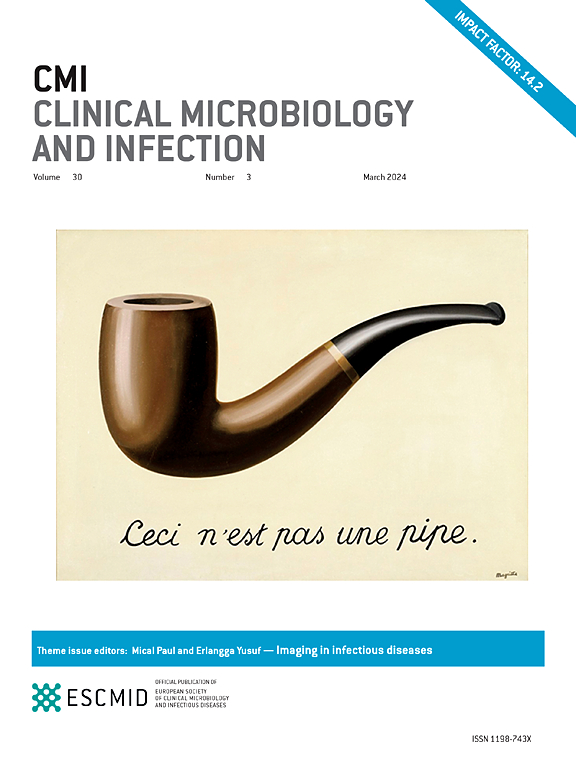与未暴露的婴儿相比,子宫内暴露于 SARS-CoV-2 或 mRNA COVID-19 疫苗的婴儿的神经发育结果:COVI-PREG 前瞻性队列研究。
IF 10.9
1区 医学
Q1 INFECTIOUS DISEASES
引用次数: 0
摘要
目的:目前尚缺乏有关 SARS-CoV-2 和 COVID-19 mRNA 疫苗对宫内暴露婴儿的长期影响的数据。我们的目的是评估产前接种 SARS-CoV-2 或 mRNA-COVID-19 疫苗的婴儿在出生后 12 个月的神经发育情况:方法: 2021年至2023年期间,对母亲在怀孕期间接触过SARS-CoV-2或mRNA-COVID-19疫苗,或未接触过病毒或疫苗的婴儿进行了登记。产前接触过病毒或疫苗的婴儿与产前未接触过病毒和/或疫苗的婴儿进行了比较。父母在婴儿出生后 12 个月时会收到一份神经发育问卷 (ASQ-3),评估 5 个子领域:沟通、粗大运动、精细运动、解决问题和个人社交发展。结果:共纳入 330 名婴儿(SARS-CoV-2 组 76 名;mRNA-COVID-19 疫苗组 153 名;参照组 101 名)。与参照组相比,宫内接触 SARS-CoV-2 或 mRNA-COVID-19 疫苗与至少一个子域的低分风险增加无关。粗略的几率比分别为 1.16(95% 置信区间 [CI]:0.59-2.28)和 1.04(95% 置信区间 [CI]:0.58-1.86)。多变量分析的结果仍然一致,与参照组相比,接种过 SARS-CoV-2 或 mRNA-COVID-19 疫苗的婴儿至少在一个子域中得分低的风险没有增加。调整后的几率比分别为 1.74(95% CI 0.76-3.99)和 0.76(95% CI 0.39-1.49):结论:宫内接种SARS-CoV-2或mRNA-COVID-19疫苗与出生后12个月时至少一个ASQ-3子域得分低的风险增加无关。需要进行更多的研究来证实我们的结果,特别是对婴儿发育进行更长期的评估。本文章由计算机程序翻译,如有差异,请以英文原文为准。
Neurodevelopmental outcomes of infants after in utero exposure to SARS-CoV-2 or mRNA-COVID-19 vaccine compared with unexposed infants: a COVI-PREG prospective cohort study
Objectives
Data are lacking regarding the long-term consequences of SARS-CoV-2 and COVID-19 mRNA vaccine on infants exposed in utero. We aimed to evaluate the neurodevelopment of infants exposed prenatally to SARS-CoV-2 or mRNA-COVID-19 vaccine during pregnancy at 12 months after birth.
Methods
Infants born to mothers exposed to SARS-CoV-2 or mRNA-COVID-19 vaccine during pregnancy, or unexposed to either the virus or the vaccine were enrolled from 2021 to 2023. Infants with prenatal exposure to the virus or vaccine were compared with infants without prenatal exposure to the virus and/or vaccine. Parents received a neurodevelopmental questionnaire (ages and stages questionnaire third edition) at 12 months after birth assessing five subdomains: communication, gross motor, fine motor, problem-solving, and personal social development. A low score was defined as <2 standard deviations below the normative mean in at least one of the subdomains.
Results
A total of 330 infants were included (76 in the SARS-CoV-2 group, 153 in the mRNA-COVID-19 vaccine group, and 101 in the reference group). In utero exposure to the SARS-CoV-2 or mRNA-COVID-19 vaccine was not associated with an increased risk of a low score for at least one subdomain compared with the reference group. The crude ORs were 1.16 (95% CI, 0.59–2.28) and 1.04 (95% CI, 0.58–1.86), respectively. Results remained consistent in the multivariate analysis, showing no increased risk of a low score for at least one subdomain for infants exposed to the SARS-CoV-2 or mRNA-COVID-19 vaccine, compared with the reference group. The adjusted ORs were 1.74 (95% CI, 0.76–3.99) and 0.76 (95% CI, 0.39–1.49), respectively.
Discussion
In utero exposure to SARS-CoV-2 or mRNA-COVID-19 vaccine was not associated with an increased risk of a low score for at least one ages and stages questionnaire third edition subdomain at 12 months after birth. Additional studies are needed to confirm our results, especially longer-term evaluation of infant development.
求助全文
通过发布文献求助,成功后即可免费获取论文全文。
去求助
来源期刊
CiteScore
25.30
自引率
2.10%
发文量
441
审稿时长
2-4 weeks
期刊介绍:
Clinical Microbiology and Infection (CMI) is a monthly journal published by the European Society of Clinical Microbiology and Infectious Diseases. It focuses on peer-reviewed papers covering basic and applied research in microbiology, infectious diseases, virology, parasitology, immunology, and epidemiology as they relate to therapy and diagnostics.

 求助内容:
求助内容: 应助结果提醒方式:
应助结果提醒方式:


